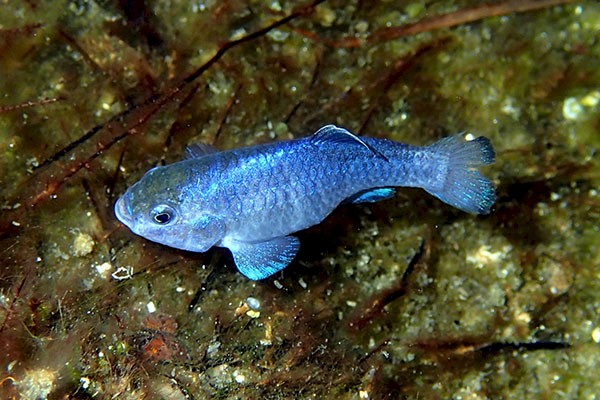

What are some of the strange, weird, magical ways that you’ve learned to propagate to seeds here at The Living Desert? Kyle: You have worked on plant propagation for a few different projects, and now Salt Creek. Only after moving to the desert did I learn of the desert pupfish specifically and see this rare fish with my own eyes. The unique ecology surrounding the Devil’s Hole pupfish was again mentioned in my studies at UC Santa Cruz. While the fish tanks I kept were saltwater reef tanks, my hobbyist friends and I loved learning about fish and aquatic ecosystems of all kinds. Their unique adaptations to a hostile environment piqued my interest and imagination. They were considered “the rarest fish in the world,” according to their Wikipedia page. Kyle: As an amateur aquarist growing up, I had learned of the Devil’s Hole pupfish in Death Valley. Natalie: Being new to the desert, equipped with a degree in marine biology, what were your thoughts when first introduced to the desert pupfish? Desert pupfish have likely utilized Salt Creek for millenia, and are well adapted to the wide range of water temperatures and changes in salinity found at the delta with the Salton Sea. Desert pupfish withstood the great swings in temperature, salinity and dissolved oxygen that can be found in desert aquatic ecosystems. Over the course of time, desert pupfish individuals and populations survived in conditions that no other fish did. Kyle: Western pupfishes have been evolving in California watersheds for over six million years! The desert pupfish (Cyprinodon macularius) diverged from other pupfish species around 600,000 years ago in the Lower Colorado River Basin. Natalie: Why is the desert pupfish the only native fish species to our desert? Why is it found in Salt Creek, a tributary of the Salton Sea?

During a recent fieldwork expedition, I went along the controlled marshes on the southeastern edge and saw majestic great blue herons, sleek white egrets and flocks of swimming water birds. While the sea is in great peril, some of the surrounding ecosystems are still quite alive. I started seeing pictures of this hypersaline environment and relics of old docks and boating areas. But until I moved here from the San Francisco Bay Area, that was all I knew. Kyle: I had heard that the Salton Sea is California’s largest lake, with over 300 square miles of surface area. Natalie: Had you heard of the Salton Sea before moving to the Coachella Valley? Working on habitat restoration near the Salton Sea with The Living Desert has allowed me to take part in the conservation of surrounding ecosystems. Protecting the sea and as a consequence the species which rely on it as well as the neighboring human communities has come to feel like a race against time. It was not until high school that I learned this is still a place of wonder for wildlife and a valuable ecosystem. Natalie: Growing up just south of the Salton Sea, I often heard stories of the enjoyment the Sea once brought to local communities but how the Sea had quickly become labeled as toxic due to exposed playa and mass fish die-offs. How has that changed since you started working at The Living Desert? Kyle: Natalie, growing up in the Southern California desert, tell me about your perception of the Salton Sea. We would like to thank Coachella Valley Mountain Conservancy, Bureau of Land Management, and California Department of Fish and Wildlife for their funding and cooperation of our desert pupfish conservation. The Living Desert works with these partners to restore the Salt Creek watershed (near the Salton Sea) for the conservation of the desert pupfish. The Living Desert partners with outside organizations for a majority of our conservation work. Natalie Gonzalez, Assistant Conservation Scientist, joined The Living Desert in 2020 with a degree in Ecology, Behavior, and Evolution from UC San Diego. Kyle Mulroe, Conservation Biologist and Natalie Gonzalez, Assistant Conservation Scientist March 15, 2021Īs a conservation biologist, Kyle Mulroe uses tools of biology and engineering for the conservation of wildlife at The Living Desert since 2019. A Conversation on Desert Pupfish and the Salton Sea


 0 kommentar(er)
0 kommentar(er)
